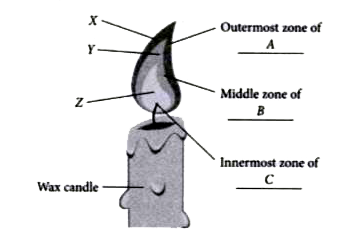Two substances A and B combine together to produce a new substance C. The properties of C do not tally with those of A and B. A and B cannot be separted into simpler substance by any chemical means . Which of the following statements is ( are ) correct about the formation of C?
A and B are elements.
A and B are compounds.
C is a mixture of A and B.
A and B are present in C in a fixed ratio by mass.
The correct Answer is:A, D
Step by step video, text & image solution for Two substances A and B combine together to produce a new substance C. The properties of C do not tally with those of A and B. A and B cannot be separted into simpler substance by any chemical means . Which of the following statements is ( are ) correct about the formation of C? by Chemistry experts to help you in doubts & scoring excellent marks in Class 9 exams.
Updated on:21/07/2023Topper's Solved these Questions
- CLASSES OF MATTER Book:BHARATI BHAWAN (ENGLISH)Chapter:CLASSES OF MATTER Exercise:B. Very Short-Answer Questions
Explore 14 Videos
- CLASSES OF MATTER Book:BHARATI BHAWAN (ENGLISH)Chapter:CLASSES OF MATTER Exercise:C. Short-Answer Questions
Explore 16 Videos
- CLASSES OF MATTER Book:BHARATI BHAWAN (ENGLISH)Chapter:CLASSES OF MATTER Exercise:IV. Mark the statements True (T) or False (F)
Explore 10 Videos
- ATOMS, MOLECULES AND IONS Book:BHARATI BHAWAN (ENGLISH)Chapter:ATOMS, MOLECULES AND IONS Exercise:E. Numericals
Explore 6 Videos
- MATTER IN OUR SURROUNDINGS Book:BHARATI BHAWAN (ENGLISH)Chapter:MATTER IN OUR SURROUNDINGS Exercise:D. Long Answer Questions
Explore 15 Videos
Similar Questions
Knowledge Check
Two substances A and B when brought together form a substance C with the evolution of heat. The properties of C are entirely different from those of A and B. The substance C is
Aa compoundBan elementCa mixtureDnone of these.The substances A and B when brought together form a substance C with the evolution of heat. The substance C is
Aa compoundBan elementCa mixtureDnone of theseWhich of the following substances do not exist as a gas at 25∘C and 1atm?
ANH3BHClCNaClDCH4
When two substances A and B are powdered together in a pestle and mortar, a larger amount of heat is given out and a substance C is formed. The properties of C are found to be different from those of A and B. It is substance C an element, compound or mixture ?
View Solutionthere are three substance X,Y and Z , the substance X, does not have a fixed melting point or boiling and it still shows the individual properties of its constituents ,the substance Y has a fixed melting point and boiling but it cannot be broken down into simpler substance by any chemical means the substance Z is also a pure substance divided by electroysis into two substance which belong to the same class of substance as Y
(a) what type of substance could X be ? Name one substance like X.
(b) what type of substance could Y be ? Name one substance like Y.
( c) what type of substance could Z be ? Name one substance like Z.
( d) which process involves absorption or release of an appreciable amount of energy : formation of substance X or formation of substance Z.?
( e) Name the three group into which all the substance like Y are divided on the basis of their properties .
View SolutionThe mean of a, b, and c is same as the mean of b, c, and d. Then which of the following is correct?
View SolutionB is the brother of A and C. Dis C's mother.E is B's father. Which of the following statements cannot be definitely true?
View SolutionA flame is the visible gaseous part of a fire. It is a zone of combustion of gaseous substances accompanied by evolution of heat and light. All substances do not burn with a flame. Only those substances that vaporise during burning produce flame. A candle flame is taken to study the various zones of a flame.

Different zones of a candle flame are marked by the letters (A), (B) and (C).
Which of the following statements are correct?
(I) (B) is the hottest part of the flame.
(II) (C) is moderately hot.
(III) (A) is the hottest part of the flame.
(IV) (A) is moderately hot whereas (C) is the coldest part.
(V) (C) is the luminous zone.
(VI) (B) is the luminous zone.
(VII) (A) is the dark zone.
View Solution
